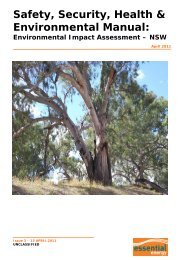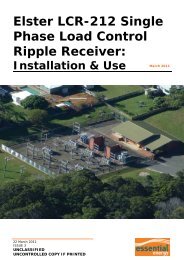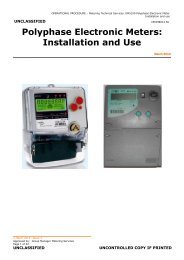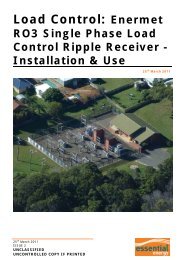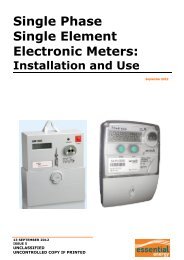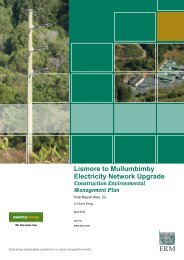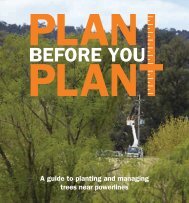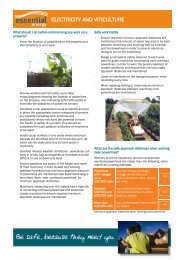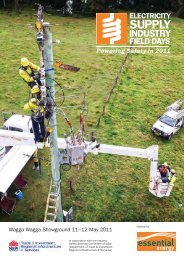CEOP8079 - Connection Guidelines - Essential Energy
CEOP8079 - Connection Guidelines - Essential Energy
CEOP8079 - Connection Guidelines - Essential Energy
Create successful ePaper yourself
Turn your PDF publications into a flip-book with our unique Google optimized e-Paper software.
UNCLASSIFIED<br />
OPERATIONAL PROCEDURE – <strong>Connection</strong> <strong>Guidelines</strong> for High<br />
Voltage <strong>Connection</strong>s and Embedded Generators<br />
<strong>CEOP8079</strong><br />
13.2.2 Transmission Powerlines<br />
Electricity works may only be owned and operated by the <strong>Connection</strong> Applicant if the asset<br />
does not supply any other customer and the <strong>Connection</strong> Applicant accepts full responsibility<br />
to comply with all laws, rules, regulations and environmental planning and approval<br />
requirements with respect to the electricity works. The <strong>Connection</strong> Applicant should also<br />
incorporate the requirements of AS/NZS 7000:2010 Overhead line design – Detailed<br />
procedures.<br />
13.2.3 HV Cables<br />
For the safe installation of HV cables the <strong>Connection</strong> Applicant should incorporate the<br />
guidelines of the cable manufacturer and any applicable standard.<br />
13.2.4 Protection<br />
The <strong>Connection</strong> Applicant / ASP must liaise and negotiate with <strong>Essential</strong> <strong>Energy</strong>‟s Protection<br />
Design team as to the type and electrical characteristics of high voltage and associated<br />
secondary equipment to be installed. This will permit <strong>Essential</strong> <strong>Energy</strong> to install and set<br />
appropriate protection schemes upstream and at the connection point. If <strong>Essential</strong> <strong>Energy</strong><br />
needs to install new and/or replace existing protection schemes as a result of this process<br />
the <strong>Connection</strong> Applicant must pay those costs.<br />
<strong>Essential</strong> <strong>Energy</strong> will require 2 months‟ notice prior to any commissioning of HV and<br />
associated secondary protection equipment.<br />
Protection design must comply with the requirements of:<br />
13.2.5 HV Metering<br />
CEOP8002 High Voltage Protection <strong>Guidelines</strong><br />
CEOP8012 Cogeneration Protection <strong>Guidelines</strong>.<br />
HV metering design and installation should comply with the requirements of the nominated<br />
meter provider.<br />
13.2.6 Load Control<br />
HV equipment must meet the requirements of the NSW S & I Rules.<br />
13.3 Testing and Commissioning<br />
13.3.1 General<br />
<strong>Essential</strong> <strong>Energy</strong> will not proceed to connect or energise any HV equipment until it is<br />
satisfied that the <strong>Connection</strong> Applicant has met the requirements of section 11.7, 11.8,<br />
Error! Reference source not found. and 12.3.<br />
Where commissioning of HV equipment is on land covered by a mining lease, <strong>Essential</strong><br />
<strong>Energy</strong> also requires confirmation that the installation meets the specified safety criteria and<br />
requirements covered by the terms of the applicable mining law.<br />
23 November 2012 - Issue 7<br />
Approved By: Group Manager Major Customer Engagement<br />
Page 26 of 36<br />
UNCLASSIFIED<br />
UNCONTROLLED COPY IF PRINTED




